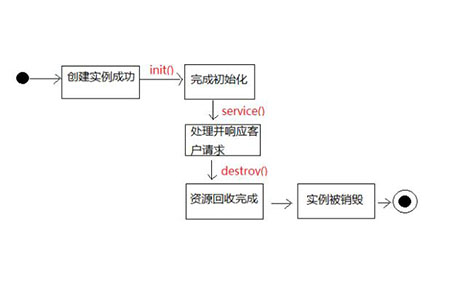What is the servlet life cycle
Servlet life cycle represents the process of Servlet from creation to destruction. It is divided into four stages: initialization stage, response to customer request stage, termination stage and garbage collection stage
The Servlet life cycle refers to the entire process of Servlet from creation to destruction. Next, I will introduce this process in detail in the article, which has a certain reference effect and I hope it will be helpful to everyone.

【Recommended tutorial: Servlet tutorial】
Servlet life cycle
The Servlet program is a Java program running on the server side, and its life cycle is controlled by the web container. The process from birth to death of a Servlet is divided into the following four stages:
(1) Construction method: This method is only called when creating a servlet object and is only called once. The purpose is to prove that the servlet object is a single instance in the tomcat server
(2) init method: used in the initialization phase, that is, called after the servlet object is created, and only called once.
(3) Service method: Used in the phase of responding to customer requests, that is, called every time the servlet is requested, called n times.
(4) destroy method: called during the termination phase, that is, called when the servlet object is destroyed. Only called once. The

#init method is called when the tomcat server is stopped or the web application is redeployed. The init() method is called after the Servlet is instantiated. During the entire servlet life cycle, the init() method is only executed once. The initialization phase includes establishing a database connection, reading source file information, etc. If the initialization phase fails, the Servlet will be directly uninstalled (note, not directly destroyed, but directly uninstalled).
When a request is submitted, the servlet calls the service() method for processing. The service() method is the core of Servlet. This method can be called multiple times, and each time a thread is created for calling. For the service method, there is generally no need to rewrite it, because it is implemented in HttpServlet. It will call doGet/doPost according to the request method, which means that the service is used for redirection, so we generally write a servlet and only need to rewrite doGet or doPost. Just doPost.
Termination phaseWhen the WEB container is closed or it is detected that a Servlet is to be deleted from the container, the destroy() method will be automatically called to release the instance. resources occupied. Note that the destroy() method can only be called once. Normally, stopping and restarting the Servlet container will cause the destruction of the Servlet object. Redeploying the project will also cause the destruction of the Servlet object and the destroy method will be called.
After destruction, the instance will wait to be recycled by the garbage collector. If this servlet is used again before it is recycled, it will be reused. init() method initialization
Summary: The above is the entire content of this article, I hope it will be helpful to everyone.
The above is the detailed content of What is the servlet life cycle. For more information, please follow other related articles on the PHP Chinese website!

Hot AI Tools

Undresser.AI Undress
AI-powered app for creating realistic nude photos

AI Clothes Remover
Online AI tool for removing clothes from photos.

Undress AI Tool
Undress images for free

Clothoff.io
AI clothes remover

AI Hentai Generator
Generate AI Hentai for free.

Hot Article

Hot Tools

Notepad++7.3.1
Easy-to-use and free code editor

SublimeText3 Chinese version
Chinese version, very easy to use

Zend Studio 13.0.1
Powerful PHP integrated development environment

Dreamweaver CS6
Visual web development tools

SublimeText3 Mac version
God-level code editing software (SublimeText3)

Hot Topics
 1378
1378
 52
52
 How does Java's classloading mechanism work, including different classloaders and their delegation models?
Mar 17, 2025 pm 05:35 PM
How does Java's classloading mechanism work, including different classloaders and their delegation models?
Mar 17, 2025 pm 05:35 PM
Java's classloading involves loading, linking, and initializing classes using a hierarchical system with Bootstrap, Extension, and Application classloaders. The parent delegation model ensures core classes are loaded first, affecting custom class loa
 How do I implement multi-level caching in Java applications using libraries like Caffeine or Guava Cache?
Mar 17, 2025 pm 05:44 PM
How do I implement multi-level caching in Java applications using libraries like Caffeine or Guava Cache?
Mar 17, 2025 pm 05:44 PM
The article discusses implementing multi-level caching in Java using Caffeine and Guava Cache to enhance application performance. It covers setup, integration, and performance benefits, along with configuration and eviction policy management best pra
 How can I use JPA (Java Persistence API) for object-relational mapping with advanced features like caching and lazy loading?
Mar 17, 2025 pm 05:43 PM
How can I use JPA (Java Persistence API) for object-relational mapping with advanced features like caching and lazy loading?
Mar 17, 2025 pm 05:43 PM
The article discusses using JPA for object-relational mapping with advanced features like caching and lazy loading. It covers setup, entity mapping, and best practices for optimizing performance while highlighting potential pitfalls.[159 characters]
 How do I use Maven or Gradle for advanced Java project management, build automation, and dependency resolution?
Mar 17, 2025 pm 05:46 PM
How do I use Maven or Gradle for advanced Java project management, build automation, and dependency resolution?
Mar 17, 2025 pm 05:46 PM
The article discusses using Maven and Gradle for Java project management, build automation, and dependency resolution, comparing their approaches and optimization strategies.
 How do I create and use custom Java libraries (JAR files) with proper versioning and dependency management?
Mar 17, 2025 pm 05:45 PM
How do I create and use custom Java libraries (JAR files) with proper versioning and dependency management?
Mar 17, 2025 pm 05:45 PM
The article discusses creating and using custom Java libraries (JAR files) with proper versioning and dependency management, using tools like Maven and Gradle.




